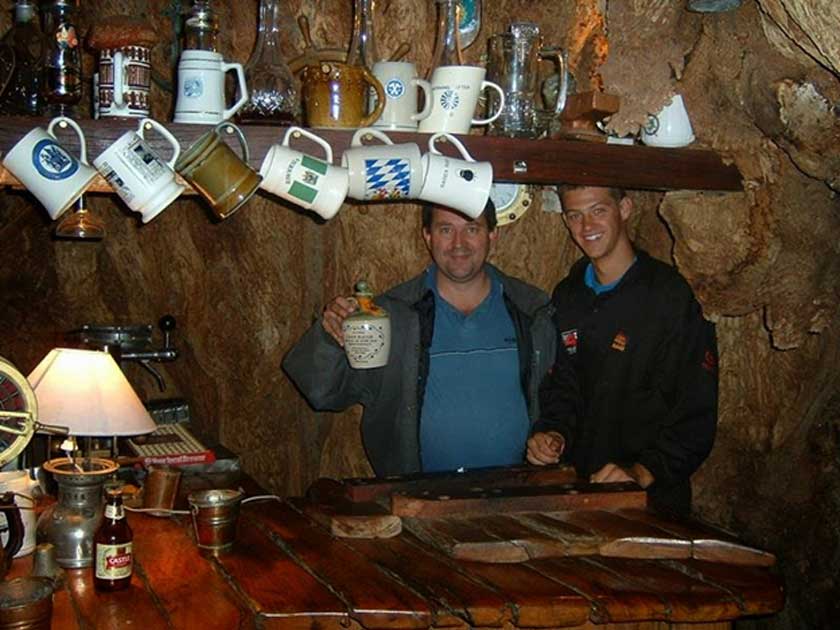Fancy Sipping a Pint in a 1700-Year-Old Tree? You Can at The Baobab Tree Bar
The Sunland Big Baobab is a bar nestled inside the hollow of a baobab tree. This bar is located on the Sunland Farm in South Africa. As baobabs begin to hollow on the inside as they age, empty caverns and caves are formed within the tree. This was the case with the Big Baobab, and the owners of the farm decided to transform the hollow interior of the tree into a bar.
The Benefits of a Baobab Tree
The baobab ( Adansonia digitata) is a type of tree found in belts across the savannahs of Africa. In addition, this tree has also been found in Madagascar, India, Sri Lanka, and Australia. This tree can grow up to a height of 25 meters (82 ft.), and are known to live for thousands of years. For example, the Sunland Big Baobab is estimated to be around 6000 years old, whilst radio carbon dating of the tree has indicated that this particular baobab is over 1700 years old.

A man standing beside a baobab. (The Fringe)
Baobabs are very useful trees to both animals and human beings. Large baobab trees are able to support their own ecosystems. Birds, for instance, make their nests in the branches of these trees, whilst their fruits are a source of food for animals like monkeys and baboons. Large animals benefit from these trees too. Elephants, for example, are known to break down and consume whole baobab trees.
- A Symbol of Peace, Victory, and Abundance: The Millennia-Old History of the Olive Tree
- The Norse Legend of the World Tree - Yggdrasil
- Oldest Bottle of Beer in the World Recovered from Shipwreck Inspires Recreation of Historic Brew

An Elephant feeding from a baobab, Tanzania. (CC BY-SA 2.0)
As for human beings, the various parts of the baobab may be put to good use. The fruit of the tree, which is known as ‘monkey bread’, is edible and the leaves are consumed as well. These leaves are rich in vitamins, and are used medically to treat various maladies such as asthma and kidney diseases. Whilst some parts of the tree are consumed, other parts may be used differently. The pollen of the tree may be mixed with water to produce glue, whilst the fiber from the bark can be turned into various objects, including rope, baskets and waterproof hats.

Baobab Fruit or ‘monkey bread’. (CC BY-SA 2.0)
Tall Tree Tales
As the baobab has such an important connection with the lives of the people living in its vicinity, various tales have been told about this tree. One of these explains the reason for the tree’s peculiar look, i.e. its branches, when leafless, resembling roots sticking in the air. According to a popular folktale, the baobab was once stood upright, just like any other tree.

Sunset over a giant baobab, it appears as if the roots are in the air. (CC BY SA 2.0)
For some reason, however, the gods got angry with the baobab, had it uprooted, and then re-planted it headfirst. According to one version of the legend, the baobab was not satisfied with what it had, and constantly prayed to the gods to be given the best features of other trees. For this reason, the gods got annoyed with the baobab, and decided to stop its complaining by burying its head underground, thus leaving its roots in the air. The scientific reason for the baobab looking like this is that the tree stores water in its trunk during the wet months which would then be used during the dry months.
- The extinct tree which has resurrected from ancient seeds
- Woe of the Witches – The Elevated Flying Rowan Tree
- New Discovery Reveals Egyptians Brewed Beer 5,000 Years Ago in Israel

The upside-down look of a bare Baobab Tree (CC BY-SA 3.0)
A Popular Watering Hole
The Sunland Big Baobab is located on the Sunland Farm, which is near Modjadjiskloof in Limpopo Province, South Africa. This farm was bought by Doug and Heather van Heerden in 1989, and half of the area was cleared to make room for mango and palm trees. The Big Baobab, however, was turned into a bar in 1993.
The van Heerdens were not the first to use the interior of the Big Baobab, however, as evidence of use by Bushmen and Voortrekkers were found when the hollow of the tree was being cleared to make way for the bar. The Sunland Big Baobab has become a popular tourist attraction in Limpopo Province, with 7000 tourists visiting the site each year.

Sunland Baobab Tree, Limpopo Province. (Image credit South African Tourism/CC BY 2.0)
Top image: A photo inside the Sunland Big Baobab. Source: Ajju Bhai King Entertaining
By Wu Mingren
References:
bigbaobab.co.za, 2017. Big Baobab. [Online]
Available at: https://www.bigbaobab.co.za/
Kaushik, 2011. Sunland Baobab - A Bar Inside a Hollowed Out Tree. [Online]
Available at: http://www.amusingplanet.com/2011/11/sunland-baobab-bar-inside-hollowed-out.html
May, G., 2016. The world's most weird and wacky bars. [Online]
Available at: http://www.telegraph.co.uk/food-and-drink/drinks/the-worlds-most-weird-and-wacky-bars/baobab-tree-bar/
Nirvana H., 2000. Baobab. [Online]
Available at: http://www.blueplanetbiomes.org/baobab.htm
Siyabona Africa (Pty) Ltd, 2017. Baobab. [Online]
Available at: http://www.krugerpark.co.za/africa_baobab.html
Spooky, 2008. The baobab tree-bar. [Online]
Available at: http://www.odditycentral.com/pics/the-baobab-bar-tree.html
Zimmer, L., 2014. Grab a Drink Inside a 6,000-Year-Old Baobab Tree at South Africa’s Sunland Bar. [Online]
Available at: http://inhabitat.com/grab-a-drink-inside-a-6000-year-old-baobab-tree-at-south-africas-sunland-bar/



















